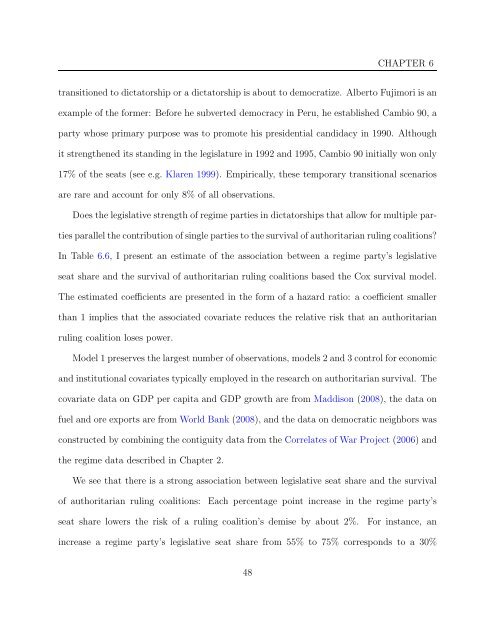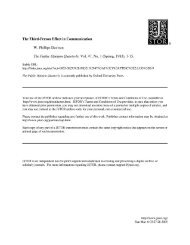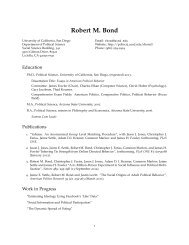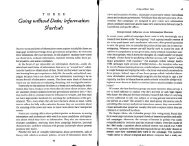Chapter 6 Why Authoritarian Parties? The Regime Party as an ...
Chapter 6 Why Authoritarian Parties? The Regime Party as an ...
Chapter 6 Why Authoritarian Parties? The Regime Party as an ...
Create successful ePaper yourself
Turn your PDF publications into a flip-book with our unique Google optimized e-Paper software.
CHAPTER 6<br />
tr<strong>an</strong>sitioned to dictatorship or a dictatorship is about to democratize. Alberto Fujimori is <strong>an</strong><br />
example of the former: Before he subverted democracy in Peru, he established Cambio 90, a<br />
party whose primary purpose w<strong>as</strong> to promote his presidential c<strong>an</strong>didacy in 1990. Although<br />
it strengthened its st<strong>an</strong>ding in the legislature in 1992 <strong>an</strong>d 1995, Cambio 90 initially won only<br />
17% of the seats (see e.g. Klaren 1999). Empirically, these temporary tr<strong>an</strong>sitional scenarios<br />
are rare <strong>an</strong>d account for only 8% of all observations.<br />
Doesthelegislative strength ofregime parties indictatorships that allow formultiple par-<br />
tiesparallelthecontributionofsinglepartiestothesurvivalofauthoritari<strong>an</strong>rulingcoalitions?<br />
In Table 6.6, I present <strong>an</strong> estimate of the <strong>as</strong>sociation between a regime party’s legislative<br />
seat share <strong>an</strong>d the survival of authoritari<strong>an</strong> ruling coalitions b<strong>as</strong>ed the Cox survival model.<br />
<strong>The</strong> estimated coefficients are presented in the form of a hazard ratio: a coefficient smaller<br />
th<strong>an</strong> 1 implies that the <strong>as</strong>sociated covariate reduces the relative risk that <strong>an</strong> authoritari<strong>an</strong><br />
ruling coalition loses power.<br />
Model1preserves thelargestnumber ofobservations, models2<strong>an</strong>d3controlforeconomic<br />
<strong>an</strong>dinstitutional covariatestypically employed intheresearch onauthoritari<strong>an</strong>survival. <strong>The</strong><br />
covariate data on GDP per capita <strong>an</strong>d GDP growth are from Maddison (2008), the data on<br />
fuel <strong>an</strong>d ore exports are from World B<strong>an</strong>k (2008), <strong>an</strong>d the data on democratic neighbors w<strong>as</strong><br />
constructed by combining the contiguity data from the Correlates of War Project (2006) <strong>an</strong>d<br />
the regime data described in <strong>Chapter</strong> 2.<br />
We see that there is a strong <strong>as</strong>sociation between legislative seat share <strong>an</strong>d the survival<br />
of authoritari<strong>an</strong> ruling coalitions: Each percentage point incre<strong>as</strong>e in the regime party’s<br />
seat share lowers the risk of a ruling coalition’s demise by about 2%. For inst<strong>an</strong>ce, <strong>an</strong><br />
incre<strong>as</strong>e a regime party’s legislative seat share from 55% to 75% corresponds to a 30%<br />
48











